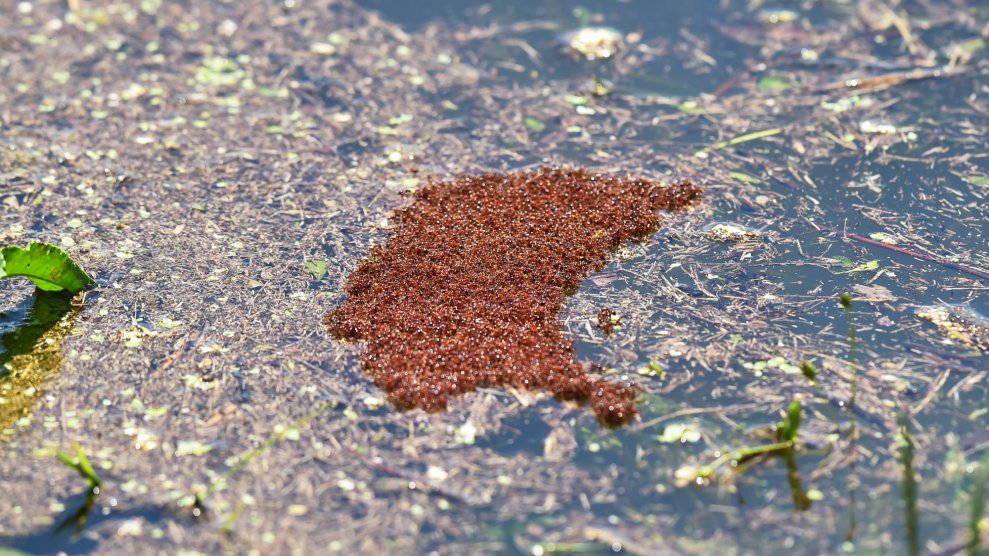Steer Clear!
"Occasionally, floating ant masses are encountered even indoors in flooded structures."
"Cuffed gloves, rain gear, and rubber boots help prevent the ants from reaching the skin. If they do, they will bite and sting. Remove them immediately by rubbing them off. If submerged, ants will cling to the skin and even a high-pressure water spray may not dislodge them. However, a spray made of diluted biodegradable dishwashing liquid may help immobilize and drown them."
Texas A&M Agrilife Extension specialist Paul Nester
 |
| Al Key/The Denton Record-Chronicle via AP |
"If the water rises, they kind of all grab a hold of each other, and they can do this for several days, until they reach higher ground."
"If one of those rafts comes in contact with you, or you try to break it apart, it will likely disperse and crawl up you."
Clemson University entomologist, Tim Davis
 |
| Waiting out the water. (AP Photo/Chris O'Meara) |
"They spread out and hook their legs and feet together so they can form a tangled mass."Houston residents had more to put up with than just the severe flooding that resulted when Hurricane Harvey struck and transformed highways into rivers, flooded homes and commercial buildings and generally made life pretty miserable. The city, originally built on a floodplain, has suffered an ongoing series of floods and will continue to, partly because nature's balance in the creation of absorptive wetlands have been paved over and partly because its proximity to the ocean invites these floods during times of natural stressors like hurricanes.
The fire ant rafts in the Houston area do pose “a definite threat [to anyone in the water],”
"If you’re walking around water and one of these rafts bumps onto you, chances are [the ants] are going to crawl up on you. You’re drier than they are."
"They’re just really unpleasant creatures."
Justin Schmidt, entomologist, University of Arizona
"You protect yourself by avoiding them, not by messing with them. They don't come to attack you. They're just passively floating along. It's a matter of being just intelligent and evasive."
"You won't feel anything for a minute. What they are doing is mustering."
"You might feel tickling, and then suddenly they are latching on so they can drag that stinger in."
"Once one of them stings it lets off a pheromone, and that makes everybody sting at once. It is like you are stepping into fire."
Larry Gilbert, professor, integrated biology, University of Texas,Austin
Not only were fish swimming about where they normally are never seen, including in people's homes, but alligators too made their presence known along the newly-created 'rivers' of floodwaters. On the other hand, strange mounds and floating rafts were also to be seen in the floodwaters, a deep rust-coloured mass, and curious to behold, comprised of thousands of fire ants, clinging together in a bid for self-preservation that overtakes the little beasts when threatening conditions arise and their primitive collective memory kicks in.
Once their underground tunnel infrastructure became flooded, they gathered and linked claws, clinging in massive rafts and balls, floating, spinning in the current of floodwaters. Nature has bestowed a waterproofed armor on their bodies to repel water and as they drifted in their teeming clumps they helped, as The Houston Chronicle wrote, create a "river full of nightmares", as in: if the alligators won't get you, the fireants might. "Those bites itch for days", wrote a medical writer for The Chronicle, of his experience of stepping on a mass of fire ants that "tore my left ankle/foot up".
Originating in South America, the fireants adapted in the wetlands of Brazil to survival in wetland floodplains there. Once they moved into the United States they adapted there too, in the southeastern region. First aid, according to the U.S. Centers for Disease Control and Prevention, takes the use of an epinephrine pen or antihistamines, since those who are allergic to insect bites stand the risk of lethal reactions. Disturbed, the ants are aggressive, attaching by their jaws to humans then injecting a venom that burns and develops fluid-filled pustules.
Subjected to long periods of disturbance such as the floods in Houston, an ant cluster reacts in fluid movements; if a small object is dropped into a mound of the insects the group simply reforms around the object, carrying it along with them. Their consistency can be wobbly resembling jelly, or it can flow like thick syrup. Connecting with the legs they create a springy network, repelling liquid. "They weave into a waterproof fabric", described David Hu, whose specialty is the study of fireants at Georgia Tech.
Labels: Animal Stories, Bioscience, Nature

0 Comments:
Post a Comment
<< Home